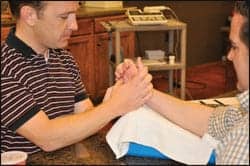
Rehabilitation of the hand after work-related trauma offers many challenging steps. In the acute phase, splinting and positioning for healing are the goals. In the subacute phase, achieving normal range of motion, increasing strength, improving sensation, and decreasing pain are often the focus. After the subacute phase, the return to work question typically arises. An objective, reliable upper extremity FCE is essential for that return to work determination. If return to work is not feasible after the initial rehabilitation, then a work conditioning program can prove extremely helpful in achieving that long-term goal. Successful return to work creates the ultimate satisfaction for the rehabilitation team, the employer, the insurance carrier, and the employee.
The following case study provides an example of effective acute, subacute, and return to work treatment. In the return to work phase of treatment, valid FCE recommendations were an important part of the return to work process.
“James” is a 52-year-old male who was referred to hand therapy after an industrial accident where he caught his right hand in a brake press. This accident resulted in a hand injury with proximal phalanx fractures of the right index, middle, and ring fingers with percutaneous pinning of each digit as well as crush injury to the soft tissue of his hand. One week after surgery, the client was splinted, immobilizing the digits and wrist, but allowing thumb motion. The patient was instructed in pin-site care and edema control measures using elevation and ice.
 |
| Co-author Deborah Lechner, PT, MS |
Three weeks later, after the percutaneous pins were removed, the client was reevaluated by this therapist with a new order for ROM as tolerated three times a week for 4 weeks. The client was found to have significant ROM deficits of the wrist and hand. Therapy was begun with a focus on range of motion. Manual therapy, CPM, blocking exercises, blocking splints, edema gloves, and PIPJ extension splints were all utilized.
In 4 weeks, the client had increased wrist range of motion to within functional limits of 65 degrees of wrist flexion and 70º of wrist extension. Other wrist motions (pronation, supination, radial and ulnar deviation) were also now normal. Finger flexion had improved, but the client still had a 4 cm lag between tips of his digits and palm.
Treatment continued for an additional 6 weeks with minimal progress in increasing hand range of motion. Strength and dexterity due to hand range of motion limitations were significantly altered. At this point (3.5 months postinjury), the decision was made to utilize the Colditz Method of mobilization casting to increase flexibility of the interossei and improve hand and finger range of motion. After 3 weeks of continuous mobilization casting and 3 weeks of intermittent casting, the client had increased total active motion of digits to allow for tip to palm pinch of all digits except the third digit, which had a .5 cm tip to palm lag.
These goals were achieved at approximately 5 months after injury. At this point, the client was motivated to return to work and eager to participate in return to work testing The physician and case manager requested an FCE to determine the client’s physical functional abilities. In addition, an impairment rating was requested to assist the client’s insurer with the workers’ compensation case settlement.

From the Rehab Management archives: Want more information on the treatment of hand injuries? Read “Healing Hands.”
The physician and case manager felt the FCE was important to provide objective data that the physician could use when making return to work decisions. He felt that without an FCE, his return to work decision would be a clinical guess, at best. With a well-designed FCE, he felt he would be making his decision on performance-based measures that provide objective information for his return to work decision.
Well-designed FCEs are not unlike other well-designed clinical measures, and should cover all the domains of the variables being examined. They should be comprehensive and standardized, yet flexible enough to mimic “real world” work demands to perform job-specific testing. They should be safe, objective, feasible, reliable, and valid. Optimally, FCE procedures are based on scientific evidence in the literature.
Safety in FCE testing primarily focuses on preventing further injury during the testing process. Injury can occur as a result of placing excessive demands on the client’s musculoskeletal, cardiovascular, or neurological systems. Safety is enhanced by stopping the client on tasks at the point where the activity begins to appear unsafe. The determination of the safe maximal level involves clinical decision-making and a therapist’s professional judgment. Clear operational definitions and specific decision-making criteria help to standardize the decision-making process and protect the client from overexertion.
Objectivity simply means that a measure is as free as possible from observer bias. Therapist observation of function can be objective if the procedures and parameters of observation and the scoring system have been operationally defined. Clinical judgment can never be removed from the FCE process, nor would it be desirable to do so. However, standardizing and objectifying the testing process to facilitate consistent, accurate, and unbiased evaluation is desirable.
Reliability refers to the consistency of a measure. Two types of reliability are important to an FCE: intra-rater or test-retest reliability and inter-rater reliability. Since individual tasks of the FCE are often selected for job-specific testing, reliability must be established for each individual task as well as for the test as a whole.
Validity is much more difficult to address than reliability. In an FCE, the validity question becomes: Can we accurately predict the level of work that an individual can perform safely? There are a variety of ways to demonstrate validity. Some are considered more scientifically rigorous than others.
Reliability and validity are not merely academic exercises intended to satisfy intellectual curiosity. They are critical to credibility in the area of physical abilities testing and make a significant difference in “real world” practice. Without reliability, the referral source could send the client to a different therapist and get an entirely different result. Without validity, the client, therapist, referral source, and employer do not know if the test results are accurate. If test results are to be upheld in litigation, therapists must be prepared to demonstrate evidence of reliability and validity for their tests.
Most FCEs are administered as the patient concludes outpatient treatment and are typically one of three types: own job, own occupation, or any occupation. An own job FCE compares the patient’s abilities to their job demands and is used in cases where the injured worker is trying to return to a former job. This type of FCE relates the test items directly to the physical demands of the client’s specific job. The own occupation FCE compares client abilities to the demands of a generic line of work as it is defined by the Dictionary of Occupational Titles (DOT). It is typically used in cases where the client has no job to go back to but wants to continue doing the same line of work. The any occupation FCE is more exploratory and tests all physical demands of work to determine what the patient can do.
FCEs can be designed to address the whole body or to focus on the upper extremity, depending on the client’s injury or illness. In this case, the client’s therapist wanted to make the FCE both job-specific and upper extremity-specific. He used an upper extremity component FCE. In order to obtain job-specific information, the clinician requested a copy of the client’s job description. After he obtained the description, however, he found that it did not provide much detail regarding the physical demands of the job. When he pointed out this weakness in the job description to the case manager, she ordered a job analysis. After he performed the job analysis and the FCE, the clinician compiled a table of job demands (see figures) that were matched to the client’s abilities and included in the FCE report.
 |
| Park administers a hand-tool test to enhance the client’s hand and finger dexterity. |
The client took this information back to his physician, who could immediately see that his abilities did not match all of his job demands. In the recommendations section of the FCE report, the clinician stated that a 4-week work conditioning program could help the client achieve his return to work goal. The therapist recommended that the program focus on the client’s lifting ability, dexterity, grip strength, and handling and fingering tolerances. He also recommended that the client be allowed to return to work performing modified duty for 4 to 6 hours per day and attend the work conditioning program 2 to 6 hours per day. The case manager approved the work conditioning program.
The therapist focused on the aspects of the job where client abilities did not match job demands and formulated a work conditioning program. To improve the client’s overall conditioning level and promote fitness for his medium level job, the client spent time each day in cardiovascular conditioning using the upper body ergometer. His lifting ability was addressed by creating a circuit of lifting, carrying, pushing, and pulling. Standard lifting boxes, a tool chest, and a weight sled were used to gradually increase weight handling abilities and tolerances.
Grip strength activities were performed with therapy putty and digital grippers. The therapy putty was used not only for gripping activities but for pinching, scraping, and twisting as well. Resistive activities in rice were used to increase grip strength. Graded therapy pins were used to increase pinch strength. Graded therapy bands and free weights were used to increase upper extremity strength in general.
Nuts and bolts assembly and the use of hand tools, including a hammer, nails, screw drivers, and wrenches, gradually increased handling tolerance, functional power grip, and manual dexterity. Several types of hand and finger dexterity tests, such as a hand-tool test, a pegboard test, hand-eye-finger movement tests, and a tweezer, were used as practice tools to enhance finger and hand dexterity. These are timed tests that can objectively document functional improvement. As the client began to use his hands more functionally and efficiently, his scores on these tests began to improve. The following tasks of the FCE were selected for continued testing to document improvement after 2 weeks.
| Physical Demands | Job Demands | Patient Abilities | Match? |
|---|---|---|---|
| Lift Below Waist | 45 lb | 25 lb | No |
| Lift Above Waist | 30 lb | 15 lb | No |
| Bilateral Carry | 45 lb | 45 lb | Yes |
| Unilateral Carry | 28 lb | 20 lb | No |
| Bilateral Push | 50 lb | 30 lb | No |
| Bilateral Pull | 46 lb | 25 lb | No |
| Waist Level Reach | Frequently | Frequently | Yes |
| Above Shoulder Reach | Occasionally | Occasionally | Yes |
| Below Waist Reach | Occasionally | Occasionally | Yes |
| Repetitive Reach | Occasionally | Occasionally | Yes |
| Handling | Constantly | Occasionally | No |
| Fingering | Frequently | Occasionally | No |
| Manual Dexterity | 3 | 1 | No |
| Finger Dexterity | 3 | 1 | No |
| Grip Strength | 40 lb | 25 lb | No |
| Pinch | 20 lb | 10 lb | No |
Figure 1. Initial FCE Job Match Table |
|||
After obtaining the results of this follow-up testing 2 weeks into the work conditioning program, the therapist communicated improvement to the client’s employer and the client was allowed to perform additional job responsibilities that included pushing and pulling and fingering. The work conditioning program was continued with progression of the graded activities. At the end of the program, the functional testing was repeated for those activities where the client did not meet job demands at the 2-week test.
| Physical Demands | Job Demands | Patient Abilities | Match? |
|---|---|---|---|
| Lift Below Waist | 45 lb | 35 lb | No |
| Lift Above Waist | 30 lb | 21 lb | No |
| Unilateral Carry | 28 lb | 20 lb | No |
| Bilateral Push | 50 lb | 50 lb | Yes |
| Bilateral Pull | 46 lb | 46 lb | Yes |
| Handling | Constantly | Frequently | No |
| Fingering | Frequently | Frequently | Yes |
| Manual Dexterity | 3 | 2 | No |
| Finger Dexterity | 3 | 2 | No |
| Grip Strength | 40 lb | 30 lb | No |
| Pinch | 20 lb | 15 lb | No |
Figure 2. Follow-up Job Match Table after 2 weeks of work conditioning. |
|||
At the conclusion of the work conditioning program, the client was able to meet job demands on all but the grip strength demands of the job where he was only 5 pounds short of the work-related goal. To address this deficiency, the therapist recommended ergonomic modifications and larger handle tools to maximize the client’s gripping capabilities and minimize the chances of developing an overuse syndrome after return to work. With this modification, he was able to return to work full time.
| Physical Demands | Job Demands | Patient Abilities | Match? |
|---|---|---|---|
| Lift Below Waist | 45 lb | 45 lb | Yes |
| Lift Above Waist | 30 lb | 30 lb | Yes |
| Unilateral Carry | 28 lb | 28 lb | Yes |
| Handling | Constantly | Constantly | Yes |
| Manual Dexterity | 3 | 3 | Yes |
| Finger Dexterity | 3 | 3 | Yes |
| Grip Strength | 40 lb | 35 lb | Yes |
| Pinch | 20 lb | 20 lb | Yes |
Figure 3. Follow-up Job Match Table after 4 weeks of work conditioning. |
|||
In summary, the successful rehabilitation and return to work of the client with a hand trauma begins with a carefully developed course of acute rehabilitation. If trauma is significant and rehabilitation prolonged, an FCE to determine client abilities compared to job demands can be extremely important in the return to work decision. The quality of this FCE is important and should be backed by research that demonstrates that the FCE is reliable and valid. If the available job description is not detailed with regard to physical demands, a job analysis will be needed. Once the testing and job match are known, this information can guide the work conditioning and transitional duty programs. Traditional therapy equipment combined with creativity and understanding of the work can create an effective return to work program. Repeat functional testing can be used periodically throughout the work conditioning program to document progress and determine when return to work is feasible. This systematic approach to rehabilitation of the injured hand is cost-effective for the client, the employer, and the insurance carrier, bringing significant benefit to all parties.
(Authors’ note: Special thanks to Beth Jones, LSW, and Donna Johnston, PTA, for assistance with editing and preparation of this manuscript.) Kevin Park, OTR/L, CHT, practices in predominantly upper extremity cases at Crossroads Rehabilitation Services Inc, New Albany, Miss, and Deborah Lechner, PT, MS, is president and founder of ErgoScience Inc, Birmingham, Ala.





